Hearing the stories of people who have attended the Upper Peninsula State Fair their entire lives, and seeing what the event means to them helps inspire future growth, said Nicole Smith, the communications director for the Delta County Chamber of Commerce, and the U.P. State Fair.
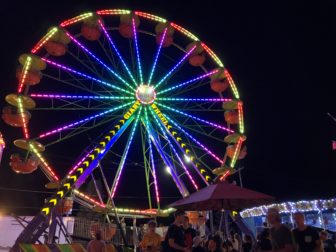
Fairgoers wait in line to ride the Ferris wheel at the 2019 U.P. State Fair. Photo by Taylor Haelterman
In the Upper Peninsula fair stories are typically not difficult to find. Like the story of Smith’s colleague who once wore her new school shoes to the fair without her mom’s knowledge, and they ended up covered in mud. This story, like many others, is now a cherished memory to share which Smith wrote about in a column to the Daily Press that focused on reminiscing on the tradition of fair week, and the memories made there.
“It’s almost a part of growing up, being a part of the state fair,” she said. “Whether you’re an exhibitor, or you hang out on the midway with your friends.”
The U.P. State Fair in Escanaba set a new attendance record in 2018 with over 92,000 fairgoers. That is an increase of 6 percent from the previous record setting year, 2017, according to an economic impact study by Steve Miller, the director of the Michigan State University Center for Economic Analysis.
One of those 92,000 attendees was Amber Stenberg, a local who has been attending the fair for over 30 years.
Stenberg said she thinks the growth in popularity of the fair has a lot to do with the diversity of entertainment you get for the ticket price.
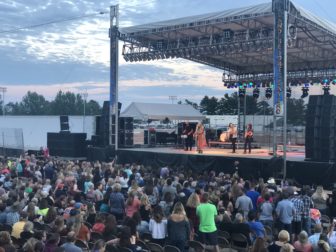
Fairgoers attend the Carly Pearce concert on opening day of the 2019 U.P. State Fair. Photo by Taylor Haelterman
“There’s more to do there, besides just rides,” she said. “There are more concerts every night, more activities and after you pay the admission fee all of that is free.”
Miller said he thinks a large part of the popularity of the fair is due to knowing the right entertainment for the audience, and good marketing, but another important aspect is the common identity of Yoopers and their support of all things local.
“The U.P. as far as a common identity, people really relate to it, so they’re willing to really support the local events,” he said.
Local attendance is an important aspect of the economic impact of the fair in the form of an impact Miller calls local money. If the fair keeps community members from going outside of the community to spend money on another event the money they spend at the fair can be counted as new money to the local economy. For the study, fairgoers from Alger, Delta, Dickinson, Marquette, Menominee and Schoolcraft counties were considered local. However, for the 2018 study Miller’s attention was on fairgoers who were not from the local region.
The study was focused on the estimated 57,741 attendees at the 2018 fair who were from outside the local region. The non-local attendance is important because revenue from people outside of the local economy brings in new money that would not otherwise have been spent locally, said Miller.
Non-local attendees generated about $1.8 million in new expenditures in 2018, which is new economic activity, according to the study.
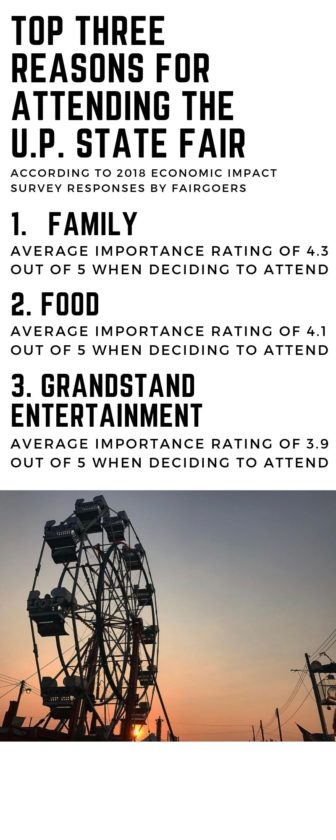
The top three reasons for deciding whether or not to attend the fair listed on surveys from the 2018 economic impact study. Graphic by Taylor Haelterman
“It’s the only state fair left in Michigan, so it does draw in a lot of visitors from outside the community,” Miller said. “And, when they spend in the community that means there is wealth from one part of the state that’s been transferred to this local part of the state, and that’s the important component of the economic impact.”
Those non-local attendees can be drawn in from advertising and social media, which Robert Micheau, executive director of Visit Escanaba, said has been amped up the past couple of years.
Visit Escanaba helps to manage the fair’s marketing and social media campaigns, as well as run the fair website. Micheau said he thinks this has a significant impact on the attendance growth because they can reach a much larger group of people.
“It’s amazing how popular (fairs) are,” he said. “They’re great events for families, and it just has such a broad appeal that when you can raise awareness with people, and let them know there’s a fun event like this going on up here you get a lot of attendees.”
According to the economic impact study, it is estimated “the 2018 U.P. State Fair generated $1,889,296 in captured, new economic spending in the local economy.” Some of that money then re-circulates into the economy to generate another $875,016. Both of those factors combined means the fair generates enough money to support 29 local jobs.
Miller said the study compared the money generated to jobs because jobs are easy to relate to, but when the fair only occurs for seven days it can be difficult to understand that it is making an impact over a longer period. The fair may not have necessarily created new jobs in the community, but it creates revenue that can sustain jobs that are already existing, or the event itself could create extra hours for workers during fair week.
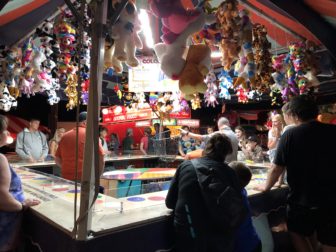
Fairgoers play at a game booth at the 2019 U.P. State Fair. Photo by Taylor Haelterman
“If that level of new transactions that occurred were spread out over the course of a full year instead of bunched all together in one week that would be how many jobs would be supported,” Miller said. “But, because it is a temporary event it’s kind of hard to justify that there actually are those jobs being created.”
Another part of the study involved sending surveys to local businesses not involved with the fair. Some of the businesses responded that they had extra staff during fair week to cover the overwhelming amount of traffic they received, while others lost business, depending on what goods and services they offer, said Smith.
“There’s an ebb and flow to it,” she said. “But, I think that’s just the nature of business in general.”
This economic impact on businesses expands further than Escanaba, said Ed Legault, executive director of the Escanaba Downtown Development Authority, because while at the fair tourists have the opportunity to see what the Upper Peninsula has to offer, and learn about attractions they would like to come back and see.
“(The fair) is the crown jewel of all the events,” he said. “But, it really helps draw people to the area throughout the year just because they’ve come here for the fair.”
The impact of the U.P. State fair on the local economy is significant, but there is more to it than just economic value, said Miller.
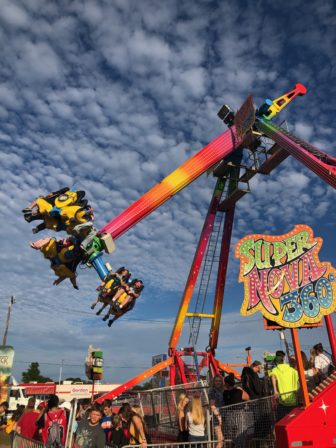
Fairgoers sit on one of the rides at the 2019 U.P. State Fair. Photo by Taylor Haelterman
“There’s so much about placemaking that we can’t capture in these economic impact numbers,” he said. “Because we’re just taking the event and we’re looking at it in somewhat of a static sense . . . But, if you have a place that’s vibrant, a good close cohesive community that shares a common vision you have a much more attractive place. And, the economic impact of that placemaking can be much more substantial than the static economic impacts of just hosting the event.”
This year marks the 10-year anniversary of the U.P. State Fair transition from being State funded to being run by the U.P. State Fair Authority.
The hard work of everyone involved in putting on the fair is the reason it has become what it is today, and their passion is what continues to improve it, said Legault.
“It’s something that, as someone locally, we should all be very excited about,” Legault said. “We had the initiative to take over the fair when, maybe, it was going to close. The Upper Peninsula State Fair is the only state fair still in existence in Michigan.”
This year’s fair will be held from Aug. 12-18. For more information visit the U.P. State Fair website.